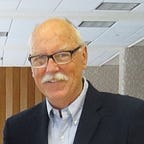What’s Behind This Inflation?
Yesterday, Jerome Powell, Chairman of the Federal Reserve, testified before the US Senate. It’s an exercise that Powell performs twice yearly before the Senate and the House of Representatives. And once again, as he’s been doing for nearly two years now, Powell emphasized that the goal of the Fed will be to bring Inflation down to 2%. It will be a remarkable achievement if the Fed can accomplish that goal.
To put that in perspective, I’ve included a long-range chart of Inflation using the Fed’s favorite measure, the Personal Consumption Expenditures version of Inflation. PCE Inflation is what Powell is talking about when he talks about Inflation.
The chart goes back more than 60 years. You’ll note that for 31 years, from 1965 until 1996, Inflation was well above 2%. Inflation soared above 10% in 974 and 1980, with an average inflation rate of over 5% for those 30 years.
Finally, in 1997, Inflation dropped below 2% for the very first time in the modern era and was able to bounce around that level until last year, when Inflation took off again. Today, Inflation is well above Powell’s 2% target.
Yesterday, Powell laid out his case in his opening statement:
“My colleagues and I are acutely aware that high Inflation is causing significant hardship, and we are strongly committed to returning Inflation to our 2 percent goal. Over the past year, we have taken forceful actions to tighten the stance of monetary policy. We have covered a lot of ground, and the full effects of our tightening so far are yet to be felt. Even so, we have more work to do.”
Wall Street analysts took this to mean that the Fed will be raising interest rates longer and farther than previously suggested. At their next meeting, on the 21st and 22nd of this month, the odds now favor the Fed raising rates by 50 basis points instead of the 25 basis points they raised last meeting. Instead of this being the terminal rate, the Fed will likely continue boosting rates for several months after this.
The last time we saw a Fed this Hawkish was in the 1980s — when the Economy was vastly different than it is today.
During the 1980s, we had a young, productive workforce that would power the Economy for years. The 80s were when the Baby Boomers reached their peak productivity and demographic peak. There were few, if any, “help wanted signs” back then because, for every job opening, there were two or three anxious boomers applying for that job.
Today, we have an aging population where more than 10,000 baby boomers are retiring daily. It’s a drop in productivity that we haven’t seen before and the reason that many economists assumed that the Fed needed to keep interest rates near zero.
Back in the 80s, the US had no significant trade deficits. So there were no “Supply Chain” issues. Although the country had endured the OPEC oil shock of a decade before, by the 80s, the country’s energy picture was bright, with a long-term agreement for low-priced OPEC oil imports.
In the 80s, the American farmer was the envy of the world, each year producing surplus crops to feed this country and much of the rest of the world.
But that was then. It was a time when all of these economic factors: demographics, “Supply Chain,” food, and energy production were all working in our favor.
As Chairman Powell pointed out, each one of these attributes has now turned negative. As he said, the Labor Market is tight, putting price pressure on wages. The Supply Chain, which reflects the goods and components we must import from overseas, is causing production delays and rising prices. Food prices, which 40 years ago were very stable, have recently turned volatile and are exerting price pressure. And the same for oil and gas prices, rising as a reflection of the rising cost of imported oil.
Throughout Powell’s testimony on the Economy, he ticked off important systemic issues that exert price pressure throughout the financial system. In short, he presented a detailed list of the fundamental contributors to Inflation.
Together, these factors are the reason why Inflation remains so stubbornly elevated. Wall Street has a word for this continued price rise: “sticky.” That is, Inflation is becoming ingrained in the financial system.
Like a fever when someone is sick, Inflation indicates how poorly the Economy is performing. Inflation then is like our economic thermometer. As Inflation has risen from 2% to over 5%, it tells us that the Economy is getting “sicker.” But the cause of that sickness, as Powell outlined, is many and varied.
Powell then takes us through the origins of our economic sickness. It comes from the high levels of job openings. These are positions that businesses would like to hire, but there don’t appear to be enough workers to fill the jobs.
We’re all familiar with the economic disorder that comes from the Supply Chain — our inability to obtain the goods and components we need from overseas suppliers.
Food and energy prices are also exerting price pressure and heightening Inflation.
However, like a fever, Inflation is merely the symptom, not the disease. When a patient has a fever, the Doctor looks for the underlying condition. But when “Doctor” Powell sees Inflation, he, and the Fed, look no further. The Fed raises interest rates to “cure” the price problem but does nothing to address the labor shortage, the Supply Chain, food, or energy shortages. Each of Powell’s Macro Issues must be addressed before we can see a significant reduction in Inflation.
Powell was spot-on in outlining our Economic Problems. Unfortunately, his answer of continued higher interest rates is not the answer.
Follow me here on Medium for more stories from the ValueSide.
